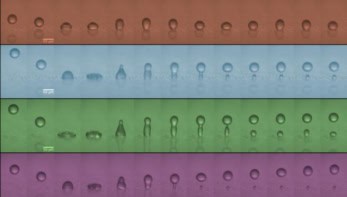
Physicists studying the flight of the fruit fly have concluded that the tiny creature’s wing motions are much closer to the movement of swimming organisms than previously thought. This surprising result lends credence to the controversial suggestion put forward by some evolutionary biologists that flight could have evolved gradually from swimming as life left the oceans.
The wings of birds and insects are structurally quite similar to the fins and paddles of aquatic animals. However, flying and swimming seem to involve completely different physical processes. Flying organisms propel themselves using the lift forces generated as a wing slices through the air, while swimming organisms paddle forward using the viscous drag of water. As a result, some biologists have doubted that flight could have evolved from swimming.
Aeronautical inspiration
Flying creatures generate force (or lift) on their wings as they move through the air. Fruit flies remain airborne by sweeping their wings back and forth in the horizontal plane to generate lift. Propulsion can be achieved by tilting the angle of the wings with respect to the horizontal plane, thereby shifting some of the lift into the forward direction.
Drag hinders performance and as a result wings tend to be highly streamlined. But now a research team at Cornell University in New York has found evidence that fruit flies might also use viscous drag during flight.
Observing the wing motions of an insect is extremely difficult: a fruit fly flaps its wings 250 times per second. Using cameras recording 8000 frames per second, the team filmed fruit flies both hovering and in forward motion at various speeds. If the flies were propelling themselves purely by tilting their wings to shift the lift forward, the tilt should have increased as they flew faster. But the footage showed that, in some cases, the wings remained almost horizontal irrespective of flight speed.
However, the flies appeared to be adjusting the tilt of their wings in a more complicated manner. When they were hovering or flying slowly, the average angle of their wings was near-vertical, with the wing tilted in opposite directions on the forward and backwards strokes. Inevitably, the drag forces of the air on the wing also push the insect back and forth, but the two cancel each other out and overall the insect does not move far.
Maximizing drag
When they wanted to fly quickly, the fruit flies tilted their wings closer to the horizontal on the forward stroke to slice more cleanly through the air and then closer to the vertical on the backward stroke to maximize drag – effectively paddling through the air.
The team claims that this is the first indication of a flying organism deliberately manipulating drag forces to generate forward thrust. “These insects have a lot of drag forces acting on them and usually these forces cancel each other, but when the insect shifts its angle of attack a little, it is able to take advantage of them very rapidly,” explains group member Itai Cohen.
David Lentink of Wageningen University in Amsterdam and the California Institute of Technology, is impressed. However, Lentink, who was not involved in the research, does sound a note of caution. “It is difficult to say that all insects apply this mechanism, especially because, compared with some other insects, the fruit fly is more of a slow, forward hovering insect than a fast, agile forward flier,” he says. Cohen’s group is currently working on a comparative study across various creatures.
Cohen emphasizes that none of this proves that flying actually did evolve from swimming. “What we are showing with this work is that controlling your forward motion is basically the same regardless of what medium you are in, so at least that part of the jump would not have been that difficult,” he explains.
The research is described in Phys. Rev. Lett. 106 178103.



